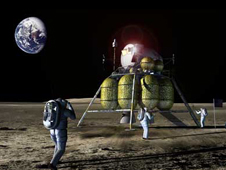- NASA Home
- | Centers
- | Marshall Home
- | Capabilities
Search Marshall
Marshall Capabilities
 Concept of a future moon landing. Image Credit: NASA/John Frassanito and Associates
Concept of a future moon landing. Image Credit: NASA/John Frassanito and AssociatesMarshall Space Flight Center's unique capabilities support today's challenging missions while preparing for future journeys of discovery beyond Earth orbit (consistency). The experienced workforce combined with state of the art facilities, are key to America's continued exploration of space. The Marshall team works together across scientific and engineering disciplines to design, develop, integrate, test, and operate complex rockets, spacecraft systems and science instruments that enable exploration and scientific discovery.
The center's expertise and facilities provide Marshall with the capabilities to take space systems and hardware from concept to operation. Marshall also benefits from valuable partnerships with industry, academia, and other government agencies to deliver vehicles, systems, and more for NASAs space exploration missions.
Marshall's unique expertise and facilities serve the needs of both the engineering community, which makes space exploration possible, and the scientific community, whose investigations fuel discoveries about the world around us and our cosmic neighborhood beyond the horizon.
Propulsion Capabilities Provide Power for the Future
Existing infrastructure and engineering expertise at Marshall help make it possible to build a new fleet of affordable spacecraft that will continue America’s journey to explore space and better understand planet Earth.
Marshall's world-class facilities for designing, building, testing, and operating space hardware and software are currently being used to reduce costs and risks, and to decrease the time required to build new launch vehicles and spacecraft. Specifically, Marshall develops and matures propulsion technologies for current and future transportation phases for space exploration and science missions, including boost, upper stage, and in-space applications. These propulsion developments are powering spacecraft such as the space shuttle and Ares rockets boosting giant telescopes to orbit and providing controlled landing and liftoff capabilities of future lunar landers.
Marshall is taking advantage of expertise and facilities across the center to bring the next generation of launch vehicles to reality. Marshall test facilities, including historic test stands such as the Dynamic Test Stand and the Saturn V S-1C Test Stand, are being refurbished for Ares tests. Marshall also houses America’s largest robotic weld tool. It will be used to build initial components of the Ares vehicles.
Marshall not only has experts and facilities for conducting traditional chemical propulsion research on advanced systems and materials for rocket engines, combustion chambers, and fuel tanks. The center also boasts state-of-the-art vacuum chambers, environmental test stands, clean rooms, manufacturing areas, liquid oxygen and liquid hydrogen test facilities and the Propulsion Research Development Laboratory, all dedicated to propelling America into the future.
Critical to the propulsion capabilities are the manufacturing and assembly facilities provided by the Michoud Assembly Facility. For the last three decades, Michoud has produced the space shuttle's large external fuel tanks, and is currently preparing to build stages of the Ares rockets and components of the Orion crew exploration vehicle that will power humanity's return to the moon.
Innovative Spacecraft & Instruments Open Windows to Scientific Discovery
Marshall has managed or developed some of the agency's most incredible scientific instrumentation that detect, observe and enable further research and study of everything from lightning and weather patterns to some of the greatest mysteries of astrophysics. Marshall Space Flight Center designed, constructed and now manages the Chandra X-ray Observatory -- the world's most powerful X-ray telescope -- to explore celestial objects from as far as billions of light years away. Marshall is also leading the Gravity Probe B mission, the Hinode solar research project, and several other important New Frontier and Discovery missions and projects for NASA.
Marshall specialists have designed optical components such as lenses, mirrors, prisms, gratings, and diffraction elements for special applications. This expertise is complemented by an extensive collection of unique advanced equipment to cut, grind, polish, and coat precision optical components and to characterize and calibrate these optics in both Earth and space environments. Marshall's expertise in optics is supported by the X-ray Calibration Facility and facilities for metrology, coating, fabrication and more.
Marshall is helping prepare the way to the moon by creating and supporting a series of initial robotic lunar mission to ensure the safety and success of the human missions to follow. An integral part of this exploration work is testing an automated rendezvous and docking system. In this unique flat floor facility, objects can float on a thin layer of air atop the world's flattest floor, allowing controllers to test techniques for spacecraft docking or remote-controlled robotics.
Connections that Make Living and Working in Space Possible
Marshall's Payload Operations Center is the science command post for American and international science activities on board the International Space Station. The Payload Operations Center's unique capabilities allow science experts and researchers around the world to perform cutting-edge science in the unique microgravity environment of space.
Marshall experts coordinate the use of valuable on-orbit resources, orchestrate delivery and retrieval of payloads, ensure safety for space station crews while working with payloads and configure complex systems on board the station to support payloads. Specialized facilities and capabilities provide near-real-time data, voice, video, information management, data reduction, and payload planning, providing scientists around the world a direct link with their experiments. This facility also supports shuttle launches, monitoring a range of propulsion parameters.
Other Resources
-

National Center for Advanced Manufacturing
NCAM addresses the manufacturing requirements of space transportation systems.
› View Site →
-

Unique Facilities & Expertise
The Marshall team works together across scientific and engineering disciplines to enable exploration and scientific discovery.
› Read More →